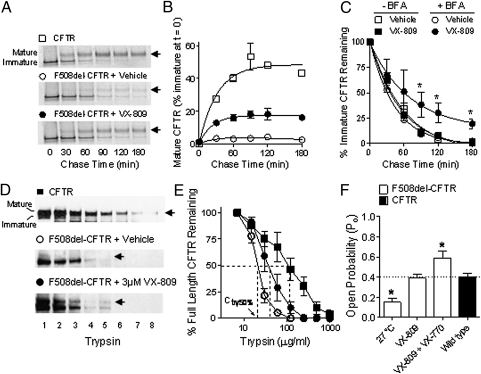Fig. 2.
Biochemical and functional data suggest that VX-809 acted at the level of the ER to allow a fraction of the F508del-CFTR pool to adopt a properly folded form. (A) Representative gels from a pulse-chase experiment shows the conversion of immature to mature CFTR in HEK-293 cells expressing CFTR (□) or F508del-CFTR following 24-h incubation with vehicle (○) or 3 μM VX-809 (•). Arrows indicate mature CFTR. (B) Quantification of mature F508del-CFTR shown in A (n = 4). (C) Quantification of immature CFTR during the 180-min chase in cells pretreated with vehicle (open symbols) or 3 μM VX-809 (filled symbols) in the presence (circles) and absence of BFA (squares). (D) Immunoblot of trypsin-digested microsomes from cells expressing CFTR or F508del-CFTR pretreated with vehicle or 3 μM VX-809 for 24 h. Trypsin concentrations were 0, 15, 30, 60, 120, 240, 480, and 960 μg/mL (labeled 1–8, respectively). Arrows indicate mature CFTR. (E) Quantification of the data in D. The trypsin concentration value required to eliminate 50% of the full-length (mature and immature) CFTR protein (Ctry50%) is indicated by the dotted lines. (F) Quantification of the Po of CFTR channels in excised membranes from NIH 3T3 cells expressing CFTR or F508del-CFTR. Cells expressing F508del-CFTR were pretreated for 48 h with vehicle or 3 μM VX-809 at 37 °C or vehicle at 27 °C. To activate CFTR, 1 mM ATP and 100 U/mL PKA were added to the bath. Acute VX-770 addition further increased the Po of F508del-CFTR following VX-809 treatment. Asterisks indicate significant difference vs. CFTR (dotted line).

